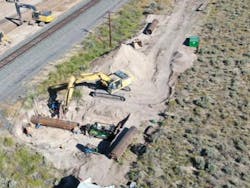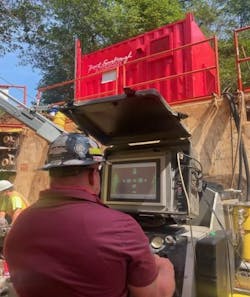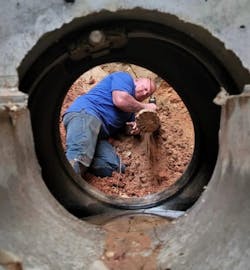The Basics of Underground Auger Boring Installations
Alongside horizontal directional drilling, auger boring, otherwise known as “Jack and Bore”, is one of the original and most utilized trenchless methodologies for underground and underwater utilities and pipelines installations. For electric cable crossings auger boring installed in 6-inch to 20-inch steal casing is preferred compared to direct bury, for added protection, high voltage lines and when multiple utilities-gas, electricity, telecommunications are installed in the same ROW. Therefore, it is important for the utility construction project managers and crews to understand how, and why, auger boring is utilized.
Design Stage
Before the start of any crossing, the owner of a project will work with the engineering firms to design the entirety of the bore path of the line that needs to be installed. Engineers must evaluate and account for any obstacles in the path of a proposed bore path, such as railroads, roads, highways, water bodies, etc. When facing these obstacles, auger boring is one of the least disruptive means of installing cable under highways, railroads etc. In other words, the highways, railroads etc.. can maintain their usage during an auger bore installation.
Compared to water, sewer, storm, gas or oil pipelines installations, where line, grade, and depths are critical, for an electric cable installation, grade is not as important, although other utilities in the corridor must be identified.
With this in mind, generally an auger bore installation is also the safest practice. Auger boring, compared to open trench methodologies, eliminates the need for an open hole or trench to be left under an obstacle, such as a highly traveled roadway.
Pre-bid Meetings
When the project makes it to the “pre-bid” phase, some utility owners will hold a meeting with pre-qualified utility construction companies. During this meeting, any of the interested parties will ask questions or bring up concerns that they may have. In most cases, the engineers will gladly review the topics covered in the pre-bid meeting to address any possible deficiencies in the design of a project before accepting bids and awarding the project to a company. In addition to the general contractors (GC) that take on the complete scope of work of a project, GC’s may retain a subcontractor who specialize in auger boring and other trenchless crossings.
Reviewing the Plans
Continuing forward, the “bore contractor” should meticulously review several factors; the ground conditions in the local area, the length of the crossing, the diameter of pipe or conduit to be installed, and, if applicable, the line and grade tolerances that the bore path must maintain.
Based on this information found in the plans, along with any additional supporting data such as geo-reports, the contractor or bore contractor determines the best equipment and tooling to complete the trenchless crossing within the parameters established by the utility engineers. Some of these decisions include auger boring machine size, cutting head style, auger size, auger hex size, all based on its own individual capability.
Types of Auger Boring Machines
Alongside the basic auger size and cutting head tooling decisions, there are two main sub-categories, which increase the reasonable capability of an auger boring installation. Traditional Horizontal Auger Boring on grade from point A to point B and Steerable systems, a means of reactive casing manipulation. The auger machines allow for critical line and grade measurements to be maintained in ground conditions that are densely populated with other utilities.
On steerable pilot tube machines, such as the Barbco Pathfinder, a laser is set up on the proposed line and grade of the crossing. This gives a “target line” to determine steering adjustments, in order to reduce the chances of a crossing falling off of the needed line and grade.
With guided systems, a “line of sight” pilot is drilled in on the proposed line and grade. During the installation of the pilot, a target is placed in the lead section of the pilot tube. This target can be clearly viewed through a “sight tube” in the middle of the pilot tube, by a camera or human eye. This is a significant advantage that has made line of sight pilots the most accurate trenchless installation methods. After a line-of-sight pilot is achieved, a cutting head is directly attached, holding the head and pipe exactly on the correct path.
Auger Bore Setup
Once a bore contractor has been awarded the project, and the size of machine utilized announced, it is time to mobilize to the site location. Upon being fully mobilized to the job site, the first thing that must be done is to survey the proposed line, in order to properly excavate a “jacking pit” and “exit pit”. Upon completing the pit excavation to the proper depth, based on matching equipment centerline to proposed vertical alignment of the bore path centerline, the auger boring machine is set up on the correct grade of the crossing. Following the completion of setup, it is good practice to stage all of the casing and auger flights, accessible to the machine.
Starting Production
The first step towards the crossing launch is “loading” the lead section of pipe with the cutting head already attached to the auger driveline. Starting a crossing, called “facing up”, on the correct path is crucial to the overall success of the crossing. Once loaded, starting the bore slowly and meticulously is critical.
Once the lead section is fully collared into the ground, the operator must properly balance the cut-to-thrust ratio, cutting the hole (auger rpm) to the forward advancement (thrust), which is an ever-changing parameter that relies on operator experience and knowledge of the tooling being used.
The Boring Process
As a crossing is fully underway, the repeating process is as follows: fully bore a section of pipe and auger, disconnect, weld, connect, and continue the bore process until the lead casing reaches the exit pit. At any time, different ground conditions may present themselves so production amount is never fully known. That is why an experienced auger boring contractor is preferred.
As soon as the lead casing reaches the exit pit, the cutting head and auger can be retracted out of the pipe installed, by simply reversing the auger and pulling it back. At this point the trenchless installation is complete, and the contractor can start the disassembly process, and groundwork to show no signs that a pipeline was installed in the area.
Auger boring is one of the safest means of any underground utility installations, keeping any roadway or waterbody fully operational all throughout the project.
John Barbera has been an employee at Barbco Inc, a manufacturer of auger boring machines, directional drills, guided boring machines and advanced tunneling equipment, utilized around the world. A10-years employ at Barbco, headquartered in East Canton, Ohio, John has specializing in different all aspects of the manufacturing process, including, assisting the completion of a variety of different trenchless crossings. Field operations has provided John a true understanding of techniques that work, and those that do not.
About the Author
John Barbera
John Barbera has been an employee at Barbco Inc, a manufacturer of auger boring machines, directional drills, guided boring machines and advanced tunneling equipment, utilized around the world. A10-years employ at Barbco, headquartered in East Canton, Ohio, John has specializing in different all aspects of the manufacturing process, including, assisting the completion of a variety of different trenchless crossings. Field operations has provided John a true understanding of techniques that work, and those that do not.



